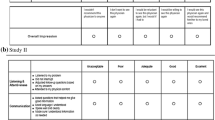Abstract
Context: Ethnicity has been a continuing concern for the valid assessment of clinical performance with standardized patients (SPs). The concern is that examinee ethnicity and SP ethnicity might interact, such that examinees might score higher in encounters with SPs of the same ethnicity.
Objective: To test for an interaction of examinee ethnicity and SP ethnicity on clinical performance in an SP examination.
Main Outcome Measures: History-taking andphysical-examination scores and interpersonal-and communication-skills scores, both based on checklists completed by SPs. Poststation scores for answers to case-related questions concerning pathophysiology, diagnosis, test selection, and test interpretation.
Setting And Participants: Two graduating classes of over 1,000 fourth-year medical students each in the New York City Consortium were tested on the SP assessment administered at The Morchand Centerof Mount Sinai School of Medicine.
Design And Analysis: The primary analyses were two-way (2 × 2) analyses, to test the main and interaction effects of examinee ethnicity and SP ethnicity. Effect-size measures (standardized mean differences, d) were computed to provide a sharper picture of the effects.
Results: Of the 24 interaction analyses, only three were statistically significant (notsignificantly more than expected by chance) and the results were mixed: one analysis showed better examinee performance in encounters with SPs of thesame ethnic background and the other two showed the opposite. For all 24 interactions, significant or not, the results showed weak effects and no consistent pattern. White examinees scored on average 0.12 standard deviations above black examinees in encounters with white SPs, and 0.11 standard deviations higher in encounters with black SPs.
Conclusions: These initial results are encouraging and should dispel some of the concern about ethnicity in SP assessment, at least about the operation of an examinee-by-SP-ethnicity interaction that would pose a serious threat to the validity of the examination scores.
Similar content being viewed by others
References
AAMC (1993). Special issue: Proceedings of the AAMC's consensus conference on the use of standardized patients in the teaching and evaluation of clinical skills. Academic Medicine 68: 437-483.
AAMC (1994). Special section: Annex to the proceedings of the AAMC consensus conference on the use of standardized patients in the teaching and evaluation of clinical skills. Teaching and Learning in Medicine 6: 2-35, 7.
Cohen, J. (1977). Statistical Power Analysis for The Behavioral Sciences. New York: Academic Press.
Colliver, J.A., Morrison, L.J., Markwell, S.J., Verhulst, S.J., Steward, D.E., Dawson-Saunders, B. & Barrows, H.S. (1990). Three studies of the effect of multiple standardized patients on intercase reliability of five standardized-patient examinations. Teaching and Learning in Medicine 2: 237-245.
Colliver, J.A., Marcy, M.L., Travis, T.A. & Robbs, R.S. (1991). The interaction of student gender and standardized-patient gender on a performance-based examination of clinical competence. Academic Medicine 66: 31-33.
Colliver, J.A., Vu, N.W., Marcy, M.L., Travis, T.A. & Robbs, R.S. (1993). The effects of examinee and standardized-patient gender and their interaction on standardized-patient ratings of interpersonal and communication skills. Academic Medicine 68: 153-157.
Colliver, J.A., Marcy, M.L., Vu, N.V., Steward, D.E. & Robbs, R.S. (1994). The effect of using multiple standardized patients to rate interpersonal and communication skills on intercase reliability. Teaching and Learning in Medicine 6: 45-48.
Colliver, J.A., Swartz, M.H., Robbs, R.S., Lofquist, M. & Verhulst, S.J. (1998). The effect of multiple standardized patients on the intercase reliability of a large-scale standardized-patient examination administered over an extended testing period. Academic Medicine 73(10): S81-S83.
Swanson, D.B. & Norcini, J.J. (1989). Factors influencing reproducibility of tests using standardized patients. Teaching and Learning in Medicine 1: 158-166.
Swartz, M.H. & Colliver, J.A. (1996). Using standardized patients for assessing clinical performance: An overview. Mount Sinai Journal of Medicine 63: 241-249.
Author information
Authors and Affiliations
Corresponding author
Rights and permissions
About this article
Cite this article
Colliver, J.A., Swartz, M.H. & Robbs, R.S. The Effect of Examinee and Patient Ethnicity in Clinical-Skills Assessment with Standardized Patients. Adv Health Sci Educ Theory Pract 6, 5–13 (2001). https://doi.org/10.1023/A:1009864529376
Issue Date:
DOI: https://doi.org/10.1023/A:1009864529376




